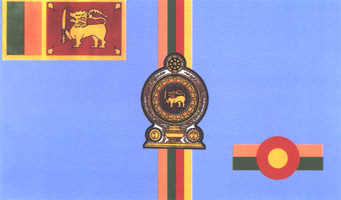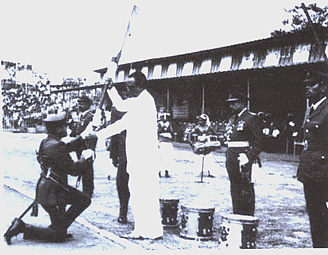An article from SLAF 25th Anniversary Souvenir
On this the Twenty Fifth anniversary of the Sri Lanka Air Force His Excellency The President of Sri Lanka, has invested the Sri Lanka Air Force, with his colour. With this bestowal of honour the Air Force which has reached mature adulthood can look back justifiable pride at its youthful record of service to the Country.
The colour is basically an emblazoned flag and its origin can be traced back to the days when monarchies were the order of the day. The King in those ancient days, would have his colour carried to battle.
The colour served as the rallying point around which the battle raged fiercest. It followed therefore that the colour became a trophy for which men would gladly die, to defend. Consequently, the colour aroused deep feelings of patriotism and pride and an almost religious aura was built around it. As the range of modern weapons lengthened the Colour no longer served as a useful rallying point and no longer was the carrying of the Colour conducive to the modern concept of war. Consequently, Colours were not taken to battle but were used only in ceremonies to lend greater dignity to such occasions.
The Colour and the awarding of the Colour are ancient customs that are etched firmly in our heritage; customs which were established long before the advent of the foreign invaders from the West. The three lions on the gateway of Sanchi (Circa 3rd Century B.C) have been identified as the Royal Arms of Sri Lanka. The peacock on it signifies the banner of the Mayura. The arch contains representation of the dispatch of the Bo-tree to Sri Lanka and the symbols on either side of the panel depict the standard of Asoka and the Sinhalese monarch Devanampiya Tissa. This is the first representation we have of the Sinhalese Royal Standard.
A 16th Century fresco at Dambulla depicting King Dutugamunu's victory over Elara shows King Dutugamunu’s Colour being borne by his Colour bearer, during the combat. The emblems on the flag are the sun and the moon, the stars and the lion with a sword in its paw. In the book titled "Sinhalease banners and standards" by Mr Edward W. Perera it is stated that the Royal flag flown in the Kotte Palace in the 18th Century was flown on a staff surmounted by the golden tassel wrought in a gold thread. At the four corners of the banner four bo leaves were worked in gold thread while the centre displayed a royal lion (Sinha Raja) holding a sword.

In Sri Lanka from the earliest times flags were carried not only in religious processions but also in war. Thus in these festival as well as in war there is little doubt, according to the historian Mr. Perera, that the addition to the standards of the kings, the banners of the princes, provinces and departments of the realm were also carried. The armies or Parakramabahu the Great marched to the conquest of South India and Pegu under the Lion Banner of Sri Lanka.
The Maha Dissawe of the four Korales of the Kandyan Kingdom who was privileged to lead the way in war as well as in the Annual Dalada Perahara, had borne before him five insignia as marks of special honour. One of the insignia is the "Ira Handa Maha Kodiya" or translated the great sun and moon flag. Elsewhere it is stated that the "Dissawas" also had the privilege of bearing the ‘Golden Tassel’ on the banner of the provinces. This is normally confined to the Royal flag but was granted as a distinction by the king to be used by the recipient.
In the Uggalboda Sannas, it is recorded that a royal grant in the period of King Sri Parakramabahu the VIth invested a chief with the privilege of bearing the king’s flag along with some other royal insignia. Thus, the sannas state, was conferred on chiefs whom the king specially delighted to honour.
Thus, it is seen that the awarding of colours is indeed a very old Sri Lankan tradition. In the chronicles it is stated that when the King’s Colour was borne, it was borne by five people; one man carried the tall pole fixed in the middle of his waist band for additional support and four other people held the ends of the cords attached to the four corners of the standard to keep it in position as it was borne along. In front of the flag, the chronicle status, went a ‘Maha-Bamba’ (a tall man) mean to avert the evil eye from the Colour to the tall fantastic figure that preceded it!
On this our "Silver Anniversary" the colour is no doubt the cynosure of all eyes. It is our fervent hope that it will continue to arouse the valiant spirit in all Air Force personnel so that those following us in hundred years may quote Sir Hamley:
A moth-eaten rag on a worm-eaten pole
It does not seem likely to stir man's soul
Tis the deeds that were done, 'neath that moth-eaten rag
When the pole was a staff and the rag was a flag.
 On this the Twenty Fifth anniversary of the Sri Lanka Air Force His Excellency The President of Sri Lanka, has invested the Sri Lanka Air Force, with his colour. With this bestowal of honour the Air Force which has reached mature adulthood can look back justifiable pride at its youthful record of service to the Country.
On this the Twenty Fifth anniversary of the Sri Lanka Air Force His Excellency The President of Sri Lanka, has invested the Sri Lanka Air Force, with his colour. With this bestowal of honour the Air Force which has reached mature adulthood can look back justifiable pride at its youthful record of service to the Country. In Sri Lanka from the earliest times flags were carried not only in religious processions but also in war. Thus in these festival as well as in war there is little doubt, according to the historian Mr. Perera, that the addition to the standards of the kings, the banners of the princes, provinces and departments of the realm were also carried. The armies or Parakramabahu the Great marched to the conquest of South India and Pegu under the Lion Banner of Sri Lanka.
In Sri Lanka from the earliest times flags were carried not only in religious processions but also in war. Thus in these festival as well as in war there is little doubt, according to the historian Mr. Perera, that the addition to the standards of the kings, the banners of the princes, provinces and departments of the realm were also carried. The armies or Parakramabahu the Great marched to the conquest of South India and Pegu under the Lion Banner of Sri Lanka.